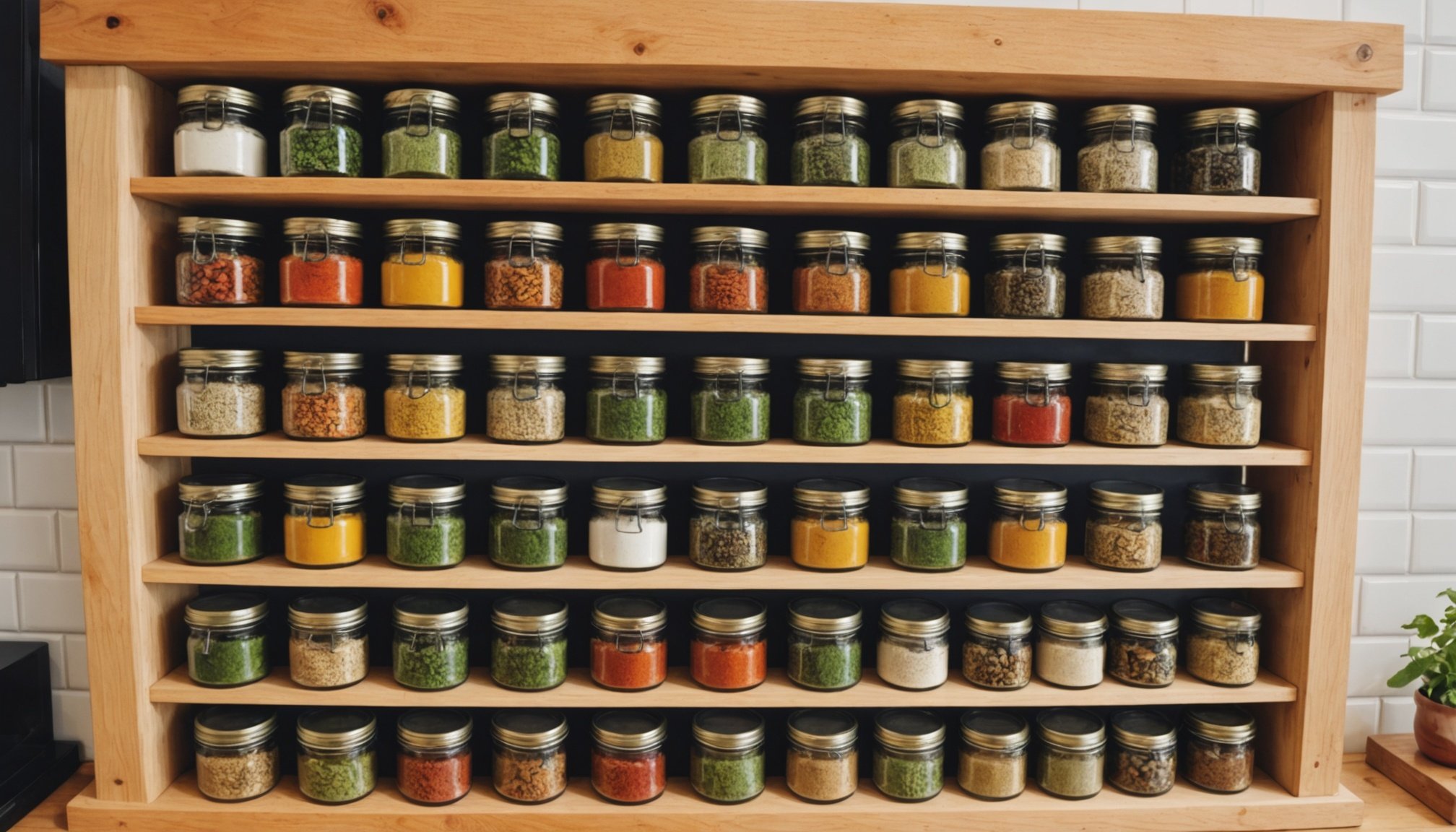Spices can elevate any dish while adding a touch of personal flair to your kitchen. Why not display them sustainably? Creating an eco-friendly spice rack not only helps you organise your herbs and spices but also reduces waste by repurposing materials you already have at home. This step-by-step guide empowers you to design a stylish and functional spice rack, blending creativity with a commitment to the environment. Discover how easy it is to nourish your culinary passion while being kind to our planet.
Overview of Eco-Friendly Spice Racks
Explore sustainable solutions for your kitchen organization.
Also to see : Essential Considerations for Buying a Countertop Convection Oven for Perfectly Even Baking
Importance of Sustainability in Kitchen Organization
Embracing sustainability in kitchen organization can significantly reduce environmental impact. Eco-friendly spice racks offer a practical solution for a more sustainable kitchen. By opting for these alternatives, you contribute to reducing waste and promoting responsible consumption.
Benefits of Using Recycled Materials
Utilizing recycled materials in creating your spice rack not only supports environmental conservation but also adds a unique aesthetic to your kitchen. These materials often include reclaimed wood or repurposed glass jars, offering durability and charm. Here are some benefits:
In the same genre : Essential Considerations for Buying a Countertop Convection Oven for Perfectly Even Baking
- Reduces landfill waste
- Conserves natural resources
- Promotes creativity and uniqueness
Overview of the DIY Project and Its Objectives
Creating a DIY spice storage system is an engaging way to personalize your kitchen space. This project aims to inspire creativity while emphasizing the importance of sustainability. By using materials you already have, you can craft a functional and stylish spice rack. The objective is to encourage resourcefulness and eco-consciousness, making your kitchen both efficient and environmentally friendly.
Engage in this rewarding project and transform your kitchen into a model of sustainability with an eco-friendly spice rack.
Materials and Tools Needed
Discover sustainable ways to gather and utilize resources.
List of Suitable Recycled Materials
When embarking on a DIY project to create an eco-friendly spice rack, selecting the right recycled materials is crucial. Consider using glass jars, which are perfect for storing spices while adding a touch of elegance. Wooden pallets can be repurposed into sturdy and rustic spice racks. These materials not only enhance the aesthetic but also support sustainability.
- Glass jars: Ideal for visibility and preservation
- Wooden pallets: Durable and versatile
- Repurposed metal tins: Adds a vintage feel
Recommended Eco-Friendly Tools
Choosing the right eco-friendly tools ensures your project remains sustainable. Opt for tools made from recycled or renewable materials. Hand tools, like screwdrivers with bamboo handles, are excellent choices. Electric tools with energy-efficient ratings can also be beneficial.
Tips on Sourcing Materials Sustainably in the UK
Sourcing DIY supplies sustainably is essential. In the UK, consider visiting local charity shops or online marketplaces for second-hand materials. Additionally, community recycling centers often have recycled materials available. By choosing these options, you contribute to a circular economy and minimize environmental impact.
Remember, each choice you make in this project is a step towards a more sustainable lifestyle.
Design Ideas for Your Spice Rack
Explore creative storage solutions to enhance your kitchen decor.
Various Design Styles
When considering spice rack design, a variety of styles can transform your kitchen space. Wall-mounted spice racks are perfect for maximizing space, keeping your spices organized and easily accessible. Alternatively, countertop designs offer convenience and can double as a decorative element.
Customization Options
Personalize your spice rack design to align with your kitchen decor. Choose materials and colors that complement your existing aesthetic. Color coding and labels are practical additions that enhance functionality and visual appeal. This customization ensures that your spice rack not only serves a purpose but also becomes a unique feature of your kitchen.
Incorporating Unique Features
To elevate your spice rack, consider incorporating unique features. Labels can help in quickly identifying spices, while color coding adds a vibrant touch. For a modern twist, integrate magnetic strips or rotating shelves. These features make your spice rack both functional and stylish.
- Wall-mounted: Saves space, easy access
- Countertop: Convenient, decorative
- Customization: Align with kitchen aesthetics
By exploring these creative storage solutions, you can create a spice rack that is both practical and a reflection of your personal style.
Step-by-Step Instructions
Follow these guidelines to craft your eco-friendly spice rack.
Preparing the Materials
Before starting your DIY spice rack assembly, ensure all materials are ready. Gather your recycled materials such as glass jars and wooden pallets. Clean and sand wooden pieces to avoid splinters. Check that all tools, like screwdrivers and saws, are in working order. Safety is paramount; wear gloves and goggles to protect against injuries.
Checklist:
- Glass jars
- Wooden pallets
- Screwdrivers
- Sandpaper
Constructing the Rack
Begin the spice rack assembly by cutting the wooden pallets to your desired size. Assemble the base using screws for stability. Attach shelves or compartments for the jars. Ensure each section is level to maintain balance. Regularly check measurements to avoid misalignment.
Construction Tips:
- Measure twice, cut once
- Use clamps to hold pieces steady
- Pre-drill holes to prevent wood splitting
Finishing Touches
To complete your DIY project, add finishing touches for durability and style. Apply a coat of eco-friendly varnish to protect the wood. Attach labels for easy identification of spices. Consider adding hooks or magnetic strips for additional functionality.
Final Steps:
- Apply varnish
- Attach labels
- Add hooks or strips
By following these project steps, your spice rack will be both functional and aesthetically pleasing.
Eco-Friendly Practices
Adopt sustainable practices to enhance your DIY projects.
Minimizing Waste
Incorporating sustainable practices into your DIY spice rack project is essential for reducing waste. Start by using every piece of material efficiently. For instance, leftover wood can be transformed into smaller components or decorative elements. Consider a bulleted list of waste minimization techniques:
- Plan cuts to maximize material use
- Save offcuts for future projects
- Compost organic waste from sanding
Eco-Friendly Paints and Finishes
Choosing eco-friendly paints and finishes is vital for an eco-conscious living approach. Opt for products labeled as low-VOC (volatile organic compounds) to reduce harmful emissions. These options are not only better for the environment but also safer for indoor air quality. Brands offering natural pigments and water-based formulations are excellent choices.
Reusing and Repurposing
The importance of reusing and repurposing cannot be overstated in DIY projects. By creatively repurposing materials, you contribute to sustainable practices and reduce the need for new resources. For example, old metal tins can be used as spice containers, adding a rustic charm to your rack. This practice encourages eco-conscious living and supports a circular economy.
By implementing these eco-friendly practices, you ensure your DIY spice rack project aligns with sustainable values and promotes a greener lifestyle.
Maintenance and Care of Your Spice Rack
Ensuring longevity and functionality for your eco-friendly kitchen solution.
Regular Upkeep
Regular spice rack maintenance is crucial for preserving both aesthetics and functionality. Consistent cleaning prevents dust accumulation and preserves the durability of your materials. Use a soft cloth to wipe down your rack weekly, ensuring all surfaces are free from grime. Pay special attention to recycled materials, as they may require gentler care.
Best Practices for Cleaning
Cleaning recycled materials involves using mild, eco-friendly detergents that won't damage or degrade the surfaces. For glass jars, a mixture of vinegar and water works wonders, while wooden pallets benefit from a light, damp cloth. Here’s a quick cleaning checklist:
- Use eco-friendly detergents
- Wipe with soft cloths
- Avoid harsh chemicals
Signs for Repairs or Upgrades
Monitoring your spice rack for signs of wear is part of effective spice rack maintenance. Look for loose screws, warped wood, or fading finishes. These indicators suggest it might be time for repairs or upgrades. Regular inspections ensure your storage remains long-lasting and efficient, keeping your kitchen organized and stylish.
By following these care tips, your spice rack will remain a valuable asset, embodying both sustainability and practicality.
Additional Resources and Inspiration
Explore a wealth of knowledge and creativity to enhance your project.
Online Tutorials and Forums
Engage with the DIY community to elevate your eco-friendly spice rack project. Online platforms like forums and tutorials offer invaluable guidance. These resources provide step-by-step instructions and share experiences from fellow DIY enthusiasts. You can find tips on sustainable practices and innovative designs that align with your eco-friendly goals.
Inspiration from Successful Projects
Draw inspiration from successful DIY spice rack projects that have embraced sustainability. These examples showcase creative uses of recycled materials and unique design elements. By examining these projects, you can gather ideas and adapt them to suit your personal style and kitchen needs.
- Innovative designs: Unique and practical
- Recycled materials: Eco-friendly and charming
- Personalized touches: Reflects individual style
Sustainable Living Blogs and Websites
For ongoing inspiration, consider following sustainable living blogs and websites. These platforms focus on eco-friendly resources and offer insights into living a greener lifestyle. They cover topics ranging from recycling techniques to energy-efficient home solutions, providing a comprehensive view of sustainable living.
Engaging with these resources ensures your spice rack project is not only successful but also contributes to a broader commitment to sustainability.













